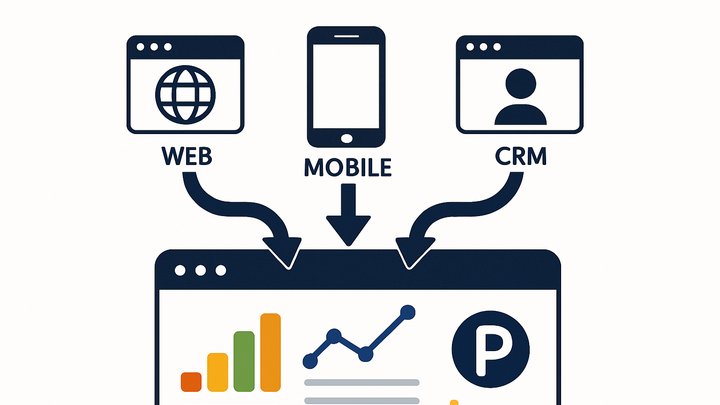Published on 2025-06-27T22:32:35Z
What is Data Unification in Analytics? Benefits & Examples
Data Unification in analytics is the process of combining data from disparate sources—web analytics, CRM systems, mobile apps, and more—into a single, coherent dataset. This consolidated view enables analysts and decision-makers to gain holistic insights, eliminate silos, and maintain consistent metrics across the organization.
Effective data unification addresses challenges such as varying data schemas, duplicate records, and privacy regulations. By harmonizing formats, resolving identities, and standardizing definitions, teams can trust that reports, dashboards, and machine learning models are drawing from accurate and complete information.
Modern analytics stacks often leverage ETL/ELT pipelines, customer data platforms (CDPs), and unified tracking solutions like Google Analytics 4 (GA4) and cookie-free tools like PlainSignal. For example, you might capture web events with GA4 and PlainSignal—one reliant on cookies and the other cookie-free—and unify these streams into a single data warehouse.
Ultimately, successful data unification empowers businesses to make data-driven decisions with confidence.
Data unification
Combining data from multiple sources into a single dataset for consistent analytics, improved insights, and unified reporting.
Why Data Unification Matters
Data unification lays the foundation for reliable analytics by breaking down silos and ensuring consistency across all data sources. It drives accurate reporting, supports a holistic customer view, and helps maintain compliance with data regulations.
-
Consistent metrics
Unifying data ensures that KPIs and metrics are defined and calculated once, preventing discrepancies between reports.
-
360° customer view
Combining web, mobile, CRM, and offline data to understand customer behavior across all touchpoints in one profile.
-
Regulatory compliance
Adhering to standards such as GDPR or CCPA requires unified records of consent and data usage, which data unification helps maintain.
Key Techniques and Tools
Several approaches and SaaS tools facilitate data unification, from ingestion to identity resolution and tracking.
-
Etl/elt pipelines
Extract, transform, and load data from sources into data warehouses. Helps standardize schemas and perform bulk transformations.
-
Fivetran
A managed ELT service that automates connector maintenance and ensures reliable data ingestion.
-
Stitch
A simple ETL platform for moving data into data lakes and warehouses.
-
-
Customer data platforms (cdps)
Platforms that unify customer data in real-time, enforce identity resolution, and provide audiences for personalization.
-
Segment
A leading CDP that captures user interactions and routes them to analytics, marketing, and data warehouses.
-
Mparticle
A CDP offering data governance, identity resolution, and real-time integrations.
-
-
Unified tracking solutions
Tools that centralize event collection and unify web and app data at the source layer.
-
Google analytics 4 (GA4)
A cookie-based and first-party solution by Google that tracks events across platforms with unified measurement.
-
PlainSignal
A cookie-free analytics tool that captures pageviews, events, and custom dimensions with privacy-centric tracking.
-
Common Challenges in Data Unification
Achieving seamless data unification involves overcoming technical and organizational hurdles that can distort insights if left unaddressed.
-
Data silos
Isolated systems and teams create data fragmentation, leading to incomplete insights.
-
Legacy applications
Older systems may not support modern API integrations, requiring custom connectors.
-
Departmental boundaries
Different teams maintain separate records, hindering a unified view.
-
-
Data quality issues
Inconsistent naming conventions, duplicate records, and missing values can corrupt unified datasets.
-
Duplicate records
Multiple entries for the same entity lead to skewed metrics and analysis.
-
Inconsistent schemas
Varying data formats require transformation rules to standardize.
-
-
Identity resolution
Linking disparate identifiers (email, device ID, cookie ID) into a single profile is complex.
-
No universal id
Without a common identifier, matching records across systems is error-prone.
-
Privacy constraints
Regulations may restrict connecting personal data across touchpoints.
-
-
Real-time vs. batch processing
Balancing immediate data availability with processing costs and technical complexity.
-
Latency
Real-time pipelines reduce lag but require more infrastructure.
-
Cost
Continuous processing can increase compute and storage expenses.
-
Best Practices for Data Unification
Implement these strategies to streamline your data unification efforts and ensure high-quality outcomes.
-
Establish a data governance framework
Define ownership, standards, and processes for data collection, transformation, and usage.
-
Adopt standardized schemas
Use common definitions and data models (e.g., OpenTelemetry, CDM) to reduce mapping overhead.
-
Leverage unique identifiers
Employ deterministic IDs—user IDs, transaction IDs—to accurately link records across systems.
-
Ensure privacy and compliance
Implement consent management and data masking to comply with GDPR, HIPAA, and CCPA requirements.
Example: PlainSignal Tracking Snippet
Implementing PlainSignal on your site provides a unified, cookie-free data stream with no PII collection by default. Use the following code to start capturing analytics events:
-
PlainSignal script integration
Add this snippet to your HTML to start capturing analytics events:
<link rel="preconnect" href="//eu.plainsignal.com/" crossorigin /> <script defer data-do="yourwebsitedomain.com" data-id="0GQV1xmtzQQ" data-api="//eu.plainsignal.com" src="//cdn.plainsignal.com/plainsignal-min.js"></script>
